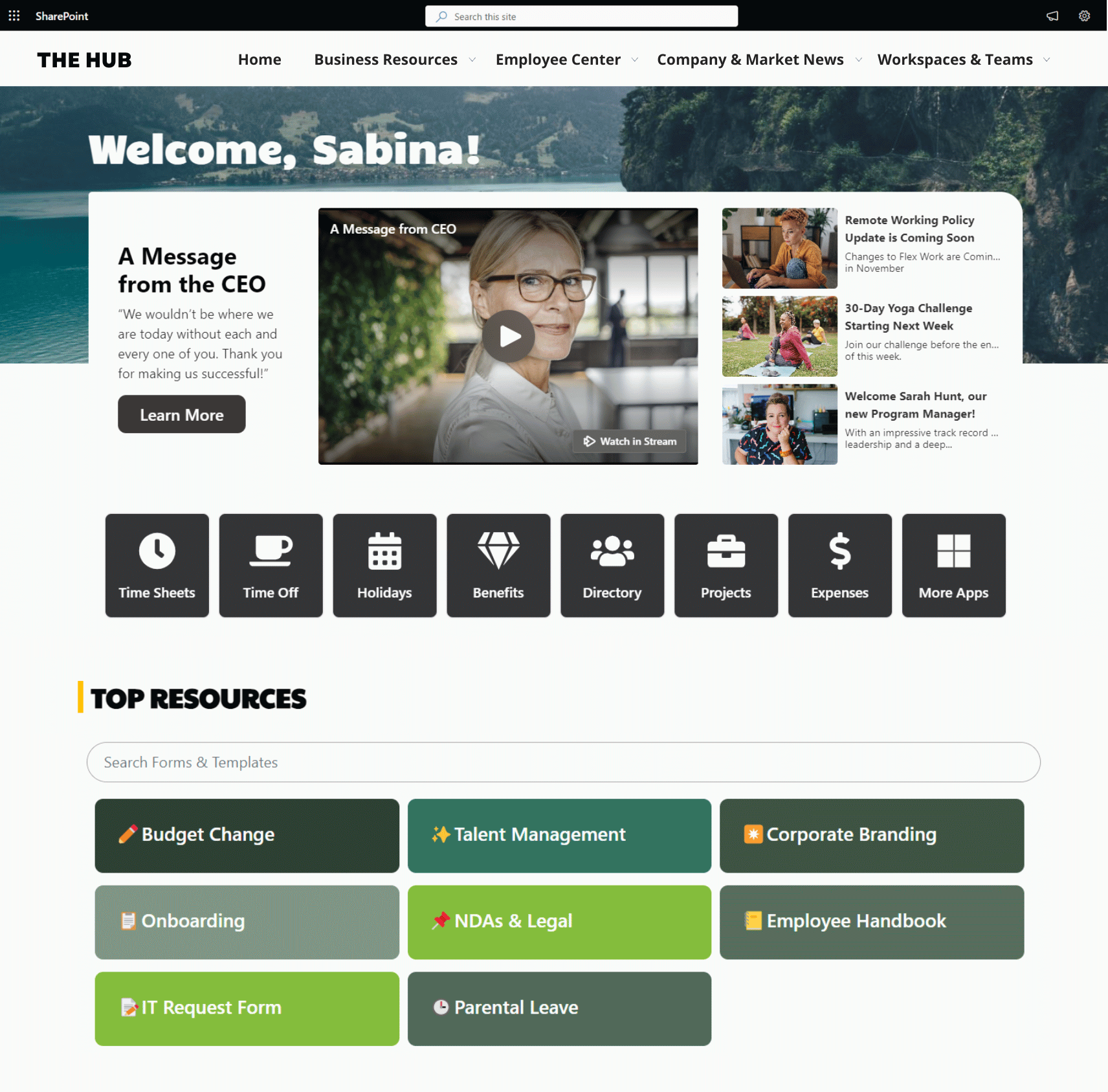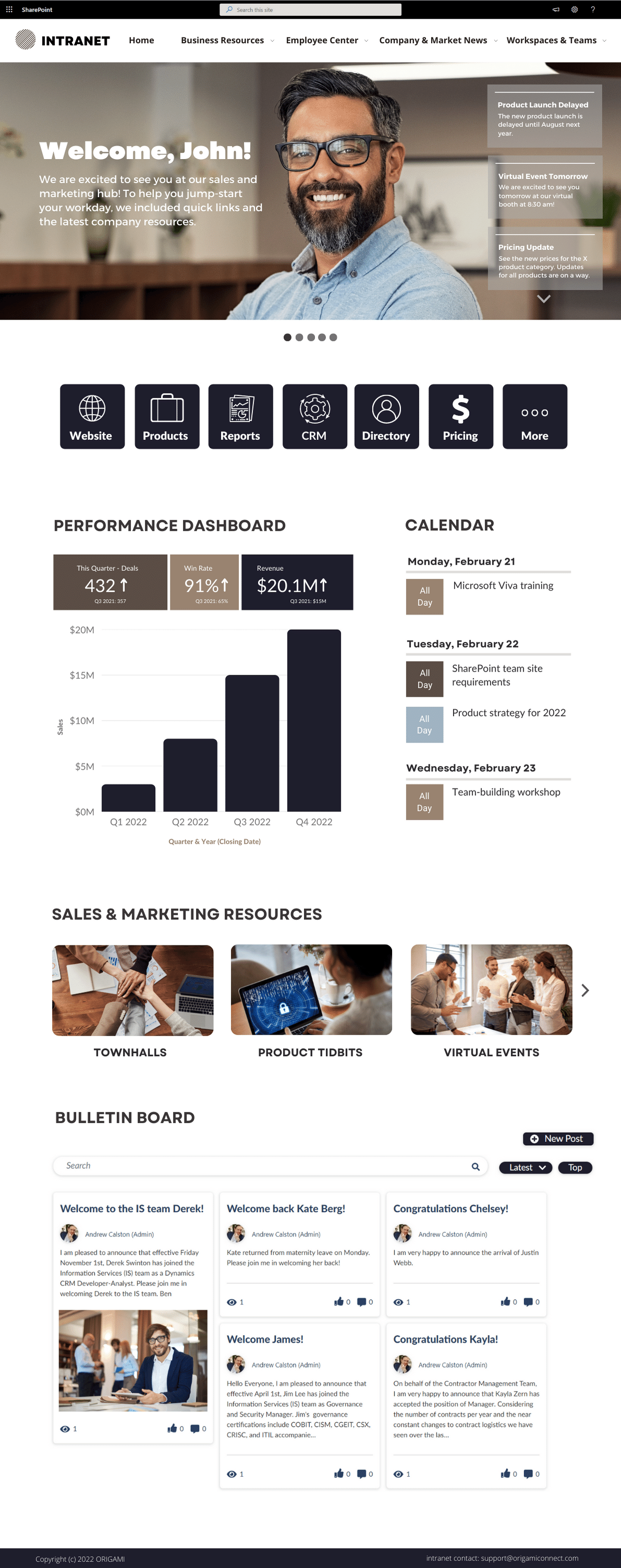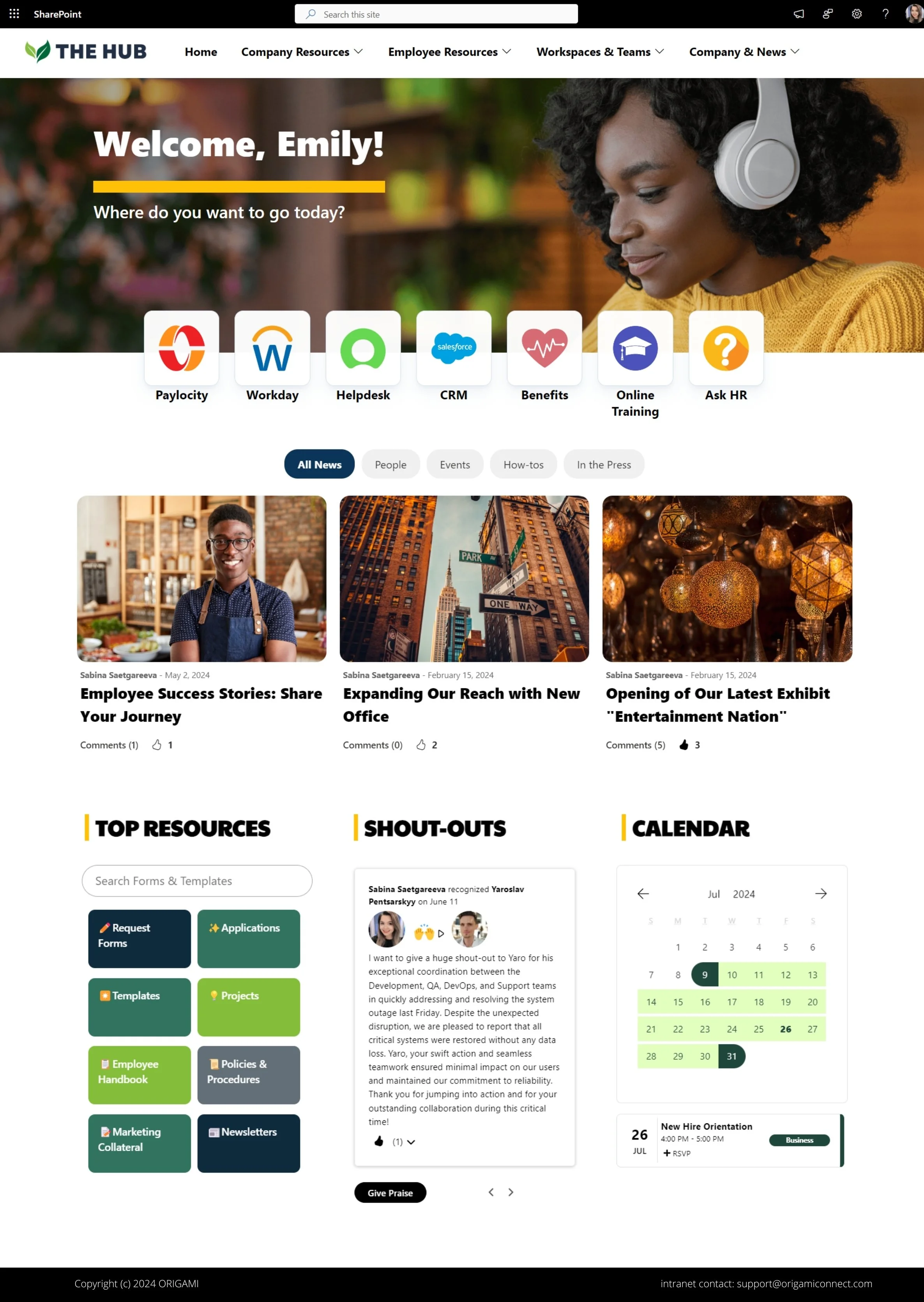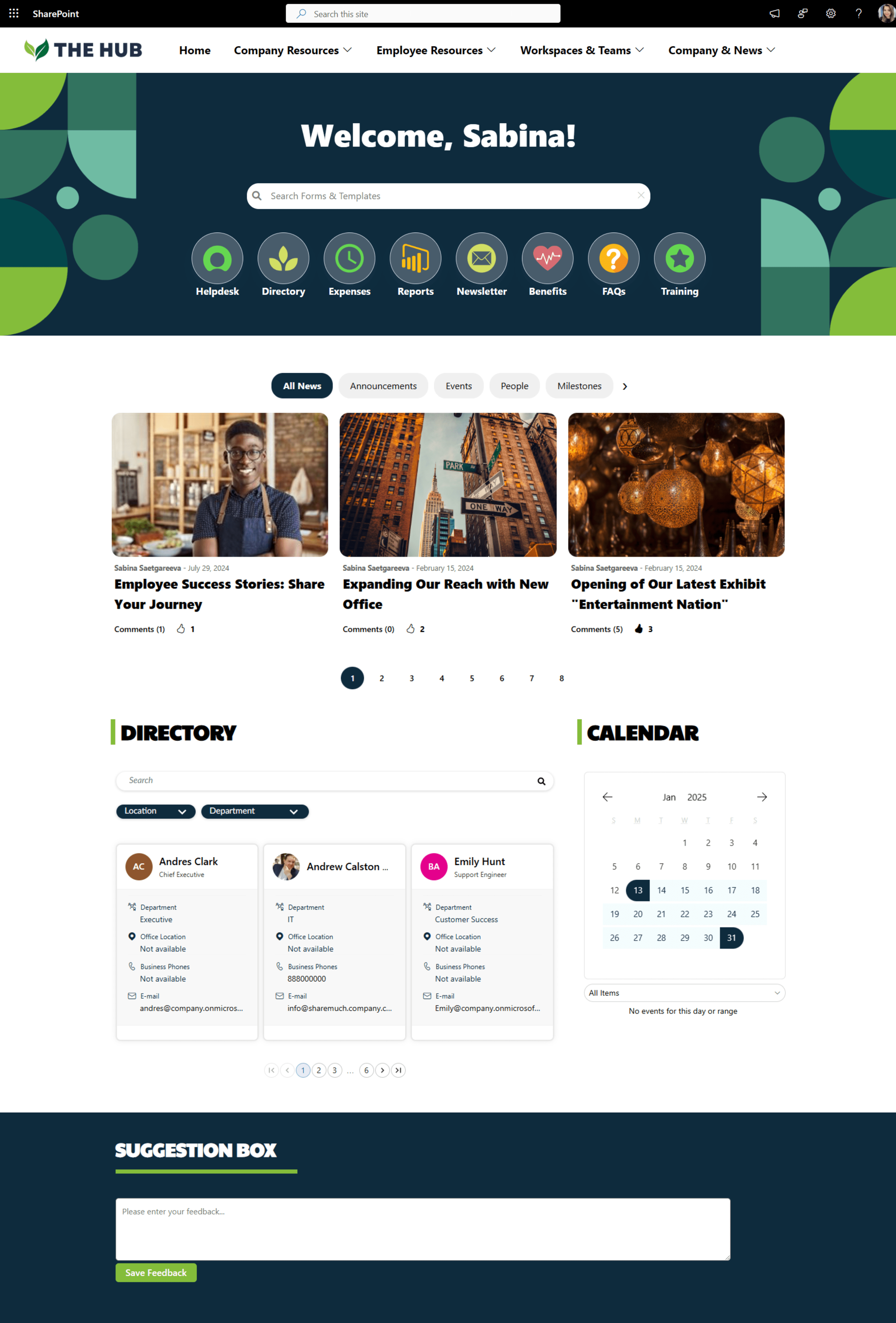We've put together several of our favorite SharePoint site examples all built using Origami to help you come up with some amazing ideas! Learn the essential components for great intranet templates today!
How much will your new intranet really cost?
Intranet Design Trends for 2023
Building a Phenomenal Information Architecture for your Intranet
34 Intranet Launch Ideas for the Best Adoption Results
5 Great Intranet Examples You Can't Miss
How to Structure Intranet Content: by Department or by Function
Creating SharePoint Intranet Governance
Summary: Intranet governance may sound complicated, but it can help you drive engaging content and decrease the burden of maintenance on your IT and Communications teams. What’s included in the initial governance list will depend on which features you’re using on your intranet. In addition to having an initial set of rules, plan to have an ongoing governance review to update the list.
Intranet governance is simply a list of processes along with responsible parties involved.
Let’s say, someone from HR wants to update an expense form template on the intranet.
Who should do it? Whoever is less busy or a specific person?
Should we keep an old version?
Should we let everyone know about the update? If so, how would we communicate this change?
Is everyone on the HR team aware of how to handle this new template?
Should anyone approve the template before it’s published?
What happens if employees have questions about the new template and, who should they contact?
As you can see, without these questions answered there are lots of potential routes. Having governance around templates, in this case, will help everyone on the intranet team understand their roles and who’s accountable for what, and the process to follow.
The alternative is to handle each request in an ad-hoc way, which increases the burden on your resources; in organizations, with > 200 users that’s not even sustainable.
What should the intranet governance document contain?
Avoid generic templates of 100 pages worth of SharePoint governance. These are too general to be useful. They provide a lot of details around out-of-the-box features but nothing related to your organization.
It doesn’t take a lot to create an efficient governance document of a few pages which tackle relevant parts of your intranet.
Here are the key SharePoint intranet governance considerations we see on every intranet project:
Sites
Creating New Generic Content Site & Team Site. If you have several templates on your site such as project sites, ensure you have checklist for those too
Naming conventions (Title and URL)
Branding
Permissions for Readers, Contributors and Owners. Ensure restricted sites have adequate permissions set up
Update to Footer Links, if the site lives under 2nd, or 3rd navigation levels
Update to other navigation links and apps
Pages
Creating a Page
Using WIKI versus Site Page
URL and naming conventions
Determine apps required for the page in this section
If apps require dependencies, add them as needed
Layout
Which page layout to use for which type of the page
[One column with sidebar]
[One column]
etc.
Content and Styles
Styles for Headings
Styles for normal text
Font sizes
Embedding rules
Home Page (this being the most prominent page it needs strict editing rules)
Rules about editing the content on the page
Rules about changing the layout of the page
Rules related to updating key apps on the home page such as new carousels, links, shout-outs, polls, etc.
Landing Pages (these are the second most prominent types of the page; they also need editing rules)
Rules about editing the content on the page
Rules about changing the layout of the page
Apps
Apps related to the home page and related rules. Such as ‘do not place more than 10 quick links on the page’, or ‘keep naming conventions of the links on the page’
Dependencies for specific apps. For example, whether apps require lists and libraries to operate, what are those, and what is the required metadata
Image resolutions for apps to best render their pages
Processes
Renaming of sites and pages to avoid broken links
Alerts on lists that collect user input
Versioning rules
Content review process
Archiving rules
Removing obsolete content
Roles and Responsibilities
An intranet contains content from a variety of sources and being able to find out quickly who is responsible for which content is not always so easy.
Every governance document must contain roles and responsibilities when it comes to key areas of running the intranet, those are:
Intranet Owners (individuals who own the home page, landing pages, and key areas of the site, they also assign area owners but are not technical users)
Area Owners (individuals who control specific areas of the site, such as HR; they also assign Area Authors)
Area Authors (individuals who create content for the area of the site)
Platform Owners (technical users who monitor and control the platform: Office 365, SharePoint, etc.)
For every area in your intranet information architecture, you need to determine who of the above will have which role, including:
Who are the key contacts?
What is the approval process?
What is the support process?
Governance Committee
The governance committee is the key to ensuring your governance evolves based on the lessons learned and decisions are made quickly to accommodate changes.
To ensure you get the most out of your governance committee, follow these key considerations:
Have a mechanism to capture issues and feedback.
Issues rarely happen randomly, they are likely a pattern or a gap that can lead to more of the same
Provide the ability to provide feedback for your users
Communicate expected SLA
Capture issues in the issues log and determine the patterns
Prioritize issues and impact (diagram below illustrates how updates can be prioritized)
Determine updates to your governance
Communicate governance changes to affected parties: Area Owners, Authors, etc
This chart illustrates how proposed governance updates can be prioritized to determine which ones to tackle next.
Conclusion
The value of governance is its practicality and transparency. The easier it is for everyone to know the process, the less of a burden managing the site will be.
Do you maintain governance plan? What are the challenges you find with it?
Yaroslav Pentsarskyy is the Director of Product at Origami. He's also 8 time Microsoft MVP, speaker at many local and worldwide tech events, and a published author of several SharePoint related books.
How-To: Create modern SharePoint site designs and SharePoint Office 365 site templates
With Office 365 you can create SharePoint site templates so that users can quickly build up their content without having to worry about configuring pages and components on them over and over again.
This technical video below demonstrates how to do that in a few steps.
In this quick how-to video, we look at how you can easily script site template provisioning in SharePoint Online modern communication and team sites.
Links in this video:
Code used in the video:
//------------------------------
// Theme Provisioning
$themepallette = @{
"themePrimary" = "#9b59b6";
"themeLighterAlt" = "#faf7fb";
"themeLighter" = "#f5eef8";
"themeLight" = "#ebdef0";
"themeTertiary" = "#d5b9e0";
"themeSecondary" = "#a569bc";
"themeDarkAlt" = "#8e4ba8";
"themeDark" = "#6e3a83";
"themeDarker" = "#572e67";
"neutralLighterAlt" = "#f8f8f8";
"neutralLighter" = "#f4f4f4";
"neutralLight" = "#eaeaea";
"neutralQuaternaryAlt" = "#dadada";
"neutralQuaternary" = "#d0d0d0";
"neutralTertiaryAlt" = "#c8c8c8";
"neutralTertiary" = "#d6d6d6";
"neutralSecondary" = "#474747";
"neutralPrimaryAlt" = "#2e2e2e";
"neutralPrimary" = "#333333";
"neutralDark" = "#242424";
"black" = "#1c1c1c";
"white" = "#ffffff";
"primaryBackground" = "#ffffff";
"primaryText" = "#333333";
"bodyBackground" = "#ffffff";
"bodyText" = "#333333";
"disabledBackground" = "#f4f4f4";
"disabledText" = "#c8c8c8";
}
Add-SPOTheme -Name "Origami Purple" -Palette $themepallette -IsInverted $false
//------------------------------
//Site Structure Provisioning
$site_script = @'
{
"$schema": "schema.json",
"actions": [
{
"verb": "applyTheme",
"themeName": "Origami Purple"
},
{
"verb": "addNavLink",
"url": "/",
"displayName": "Employee Services",
"isWebRelative": true
},
{
"verb": "addNavLink",
"url": "/",
"displayName": "Business Services",
"isWebRelative": true
},
{
"verb": "addNavLink",
"url": "/",
"displayName": "Workspaces",
"isWebRelative": true
},
{
"verb": "setSiteLogo",
"url": "https://[your logo url].png"
}
],
"bindata": { },
"version": 1
}
'@
Add-SPOSiteScript -Title "Origami" -Content $site_script -Description "Creates Origami Site Script"
Add-SPOSiteDesign -Title "Origami" -WebTemplate "68" -SiteScripts "" -Description "Origami Site"
//------------------------------
// Cleanup
Remove-SPOTheme -Name "Origami Purple"
Remove-SPOSiteScript
Remove-SPOSiteDesign
If you feel like this video is too technical, you’re not alone.
We’ve been receiving requests from many Communication Managers, Project Manager, and Designers to help them set up their intranet or a site template.
We have created a pre-built SharePoint intranet solution to help you with any customizations or configurations you may need to set up your intranet, below is an example of a modern SharePoint site template available with Origami web parts.
Yaroslav Pentsarskyy is a Director of Product at Origami. Yaroslav has been awarded as Microsoft Most Valuable Professional for 8 years in a row and has authored and published 4 intranet books.
Yaroslav is also a frequent presenter at industry conferences and events, such as the Microsoft SharePoint Conference and Microsoft Ignite.
Branding SharePoint Modern Communication Sites - Adding Corporate Color Themes
In this quick how-to video, we look at how you can apply your own company colors to SharePoint Online modern communication site. I'd call this how-to no code since small amount of code you have to copy is just copy & paste.
Links in this video:
Code used to update the theme:
$themepallette = @{
"themePrimary" = "#eab905";
"themeLighterAlt" = "#fffcf2";
"themeLighter" = "#fef9e4";
"themeLight" = "#fef3ca";
"themeTertiary" = "#fde590";
"themeSecondary" = "#fac810";
"themeDarkAlt" = "#d3a604";
"themeDark" = "#a48103";
"themeDarker" = "#816603";
"neutralLighterAlt" = "#e8dfdf";
"neutralLighter" = "#e5dada";
"neutralLight" = "#ddd0d0";
"neutralQuaternaryAlt" = "#d1bfbf";
"neutralQuaternary" = "#c9b4b4";
"neutralTertiaryAlt" = "#c3abab";
"neutralTertiary" = "#d6d6d6";
"neutralSecondary" = "#474747";
"neutralPrimaryAlt" = "#2e2e2e";
"neutralPrimary" = "#333333";
"neutralDark" = "#242424";
"black" = "#1c1c1c";
"white" = "#ece5e5";
"primaryBackground" = "#ece5e5";
"primaryText" = "#333333";
"bodyBackground" = "#ece5e5";
"bodyText" = "#333333";
"disabledBackground" = "#e5dada";
"disabledText" = "#c3abab";
}
Add-SPOTheme -Name "Origami Yellow" -Palette $themepallette -IsInverted $false
Code to remove the theme:
Remove-SPOTheme -Name "Origami Yellow"
Yaroslav Pentsarskyy is the Director of Product at Origami. He's also 8 time Microsoft MVP, speaker at many local and worldwide tech events, and a published author of several SharePoint related books.
5 Ways to Improve Corporate Culture with a SharePoint Intranet
What TIME has taught us about featuring People content on your Intranet
Why focusing on apps and widgets can really make your intranet fail?
Summary:
Focus on apps and widgets is quite common in many intranet projects but it doesn’t yield results that business users are after. Successful intranet is all about the content and helping users access this content in quick and intuitive way.As you design your intranet, perform content audit to make your intranet centered around content relevant to your users. Have a good representation of stakeholders in your workshop. Treat each app as a helper to serve content scenarios and not take over the stage.
Finally think about the maintenance of your apps if you’re considering building custom ones.
It’s about the content
Let me be very clear about one thing:
Your users come to your intranet because they need content they think they can find there.
That’s it. Everything else is a bonus.
When we talk to users about the biggest issues they face with their intranets - issues related to content are at the very top of the list, the middle of the list, and at the end.
Hard to believe? You be the judge. Here is what we hear when we start a new project and do a content audit in a form of a test:
“Actually quite hard to find things, some things are not obvious”
“I found that I had no idea about where to find half of the things on the site“
“The menu titles are really vague“
“Some of the resources took a few attempts to find what I’m looking for“
What to do:
Invest time in content audit.
Involve various content representatives in your workshop. They will be the authors of what’s going on the intranet, and they need to be there to tell you that.
Group your content by a function and not department/ownership.
If I’m looking for a template, I expect to find it in “Templates“, I don’t expect to have to figure out who would be the author of that template and then check out the site of that department. This also solves issues with content owned by multiple departments.
Include tools and apps that help finding information.
Focus on what users would look for not what you’d want them to look for.
Avoid generic roll ups such as “Recent Documents“, “Recently Updated Forms“. Ensure your forms are really the most popular before you start promoting them as such.
Allow to provide feedback easily.
If this means putting “Page Contacts“ app on your page, make sure you also include FAQ section, so authors of the page can actually post those questions they get most often and reduce the burden of answering the same things multiple times.
Apps as ingredients
Does this mean you shouldn’t have any apps? No. Think of your apps as ingredients to an amazing dish, and that means:
Adding everything can lead to surprises … often unpleasant ones
Just because you see an app on Office 365 “spice rack” think whether you add value by using it. Adding more apps to your pages just because they’re available will leave your users confused and lost.
Think of your customers
Intranet is not a meal you will enjoy all on your own. You share it, so remember to accommodate other stakeholder’s needs. The best intranets are well balanced with needs of entire organization.
Trust the recipe
It’s fine to improvise but be honest with yourself whether you’re stepping outside of your comfort zone. There is a recipe to a successful dish and there is a method to a successful intranet. Following proven methodology will save you time and money reworking the costly mistakes.
Trust the experts
Watching a YouTube video on “what’s information architecture“ doesn’t mean you can fully put one together. It’s best to acknowledge that and get qualified help before everyone starts unfavorably judging your work.
What to do:
Start with the content on sticky notes before you start building the site.
We often see this common mistake. People start adding pages and content without fully understanding what else is going in this area. You end up with disjoint site impossible to find anything on.
Build your content map on a pager using sticky notes or electronic boards. Refine, test it, and update it until it’s ready. Then you’re ready and can take to one level down and start creating sites and pages.
Use apps that help you deliver needed content.
Apps are there just to simplify access to the information not create new information that is not needed. If your users don’t need a stock ticker on the home page - don’t add it.
Think about the maintenance
Every time you think about building an app think about its maintenance, and that includes
Updates that keep it running as Office 365 changes over time
Performance.
Compatibility with evolving dependencies such as services.
Troubleshooting.
Data retention.
What to do:
Determine whether you need a custom app to serve up your specific content.
Does the app have an owner and optionally a contributor?
Determine who will maintain and troubleshooting the app.
Does the app require content moderation, is there an owner for that?
If the app has critical information, what’s the fallback plan?
Is the app compatible with the Office 365 platform in a foreseeable future or does it use approach and modules that are becoming obsolete?
What about app performance?
Does the app have consistent user experience with the rest of the site?
As you design your intranet, you will come across various alternatives, chose options which are driven by users’ demand. Ensure the demand is real and well represented and your intranet is set for success.
We’re here to help
If you have questions on how to make your intranet more engaging while leveraging your existing Office 365 and SharePoint investment, we’re here to help you make that impact.
Yaroslav Pentsarskyy is the Director of Product at Origami. He's also 8 time Microsoft MVP, speaker at many local and worldwide tech events, and a published author of several SharePoint related books.
Intranet Themes, Intranet Templates, and a Pre-Built Intranet: What's the Difference?
Intranet Themes, Intranet Templates, and a Pre-Built Intranet: What's the Difference and more importantly, before you pull out your credit card, which one do you need?
Building intranets for 15 years, I can tell you that one-size-fits-all doesn’t work.
The right solution will depend on your company size and dynamics.
How is Employee Retention linked to Employee Recognition & Feedback
Employee retention speaks volumes about an organizations culture, work environment and sometimes even management. What can organizations do to improve employee retention rates? It starts with employee recognition and ensuring the right channels are in place for encouraging kudos to achieve high employee retention rates.
If Content is King, then How Do You Help it Rule Your Intranet?
Where does Intranet fit in Your Digital Workplace Strategy
Summary:
Your Digital Workplace is not a single tool. It’s a set of tools that make work possible by complimenting each other. By evaluating new tools that come on the market in terms of their fitness on your roadmap, you can avoid tools that are roadmap-distractions and require costly backtracking. Intranets have some very clear goals and purpose in comparison to other communication tools, but you have to ensure governance and adequate support in order to make the investment worthwhile.
1. Digital Workplace: Understanding
A bit more than a year ago, at Microsoft Ignite Conference in Orlando, I had a chance to speak with Joe Francis who runs a Yammer network for over 200,000 users at Glaxo Smith Kline.
Joe and their MS Partner Leslie provided some real close-up looks on how they manage their Yammer network and how it has transformed communication within their organization.
At the time, Yammer was known in the Microsoft community to be on the “decline“. I spoke with several SME’s in the area and everyone had a nervous feeling what’s going to happen with the product. And yet it does so well at GSK.
Just 5 years ago, Yammer was considered a disruptor and many claimed it will displace SharePoint as a communication tool. But it didn’t. Now, similar disruptor stories are told about Microsoft Teams.
Many organizations are struggling to figure out how Microsoft Teams and other tools in Office 365 suite will fit their digital landscapes.
How do you know when a new tool is right for the organization?
First, let’s understand what a Digital Workplace is:
A Digital Workplace is a cohesive set of tools and environments which help the company operate successfully and drive towards a business goal.
Few key characteristics:
Each tool must have its purpose and audience in your organization
For example: you’re not trying to do project management with Yammer, just as you wouldn’t use Microsoft Project for employee communication
There is a governance around each tool and business users are not confused
Users are not mistakenly putting confidential files onto an externally accessible network
The tool belongs to a roadmap
It’s not a rogue tool installed out of someone’s impatience. Even if it’s an ad-hoc solution, it needs to have a roadmap and transition plan
2. Is the Tool a Distraction or does it belong to a roadmap?
Now that we know what the Digital Workplace is and that it can have several tools in its arsenal, let’s define the “distraction” on a roadmap.
The Roadmap
Your roadmap is a way to go from point A (now) to point B (say, 3 years from now).
A tool that is a distraction will take you on a side road and lead nowhere so you’ll have to backtrack to get back on the right path.
There are a few characteristics of a digital tool that make it a distraction.
Tool is a distraction if
It’s a short term “band-aid”; not tied to solving a business goal for the company
Example: A team needs to collaborate with a contractor who doesn’t have a corporate account, so they create a Dropbox account for them to share files with.
This action does not create a strategy for sharing files externally, it’s simply a band-aid for this one case
It doesn’t fit core values or policies of the business
Example: Help-desk team using email to ask customer for passwords
This action can result in breaches and customer information leaks
It doesn’t scale with growing demand
Example: Using Microsoft Teams channels to store project documentation
This decision might make sense temporarily but as more projects you’re assigned to, the more channels you’ll have and searching, archiving, and accessing relevant deliverables will become a nightmare as the team grows
It has visible negative impact on business goals
Example: Email blast company news
This clogs people’s email. They stop paying attention to newsletters and miss important announcements resulting in disengagement
3. Where does the intranet fit into all this?
Intranet revolves around these key goals:
Be a hub for reliable corporate communication (leadership communication, KPIs etc)
Be a one-stop-shop for corporate knowledge (templates, samples, Knowledgebase, How to’s)
Be a central spot for resources that employees need to get their job done (manuals, policies, request forms)
Be a one-stop-shop for collaboration (including: document management, findings skills and expertise through directories, launching key forms such as HR forms)
Additionally, if you don’t have any overlapping tools such as HRMS systems, your intranet can also be a place for:
Employees to connect (employee news, events, and ideas contributions)
Staff Engagement (shout-outs and kudos)
4. Setting up your intranet for success
As Joe mentions in his interview about Yammer, you have to plan for success.
Here are the key steps to implement your intranet successfully:
Solutions
Obtain Executive buy-in
Propose a pilot project. Set targets, measure outcomes, report results
Avoid the trap of Planned Obsolescence
Planned Obsolescence has several shades, here are few examples
Example 1: Instead of maintaining the service subscription companies do not renew it hoping the software will just work. Instead, the software becomes stale and users become dissatisfied with its performance
Example 2: No budget assigned for an internal resource to collect employee requests, prioritize, and action them
Example 3: No budget for increased demand on helpdesk resources when rolling out a new software
Equally represented content
Content on the intranet is often heavily tilted towards communications with very little representation for the areas of the business. This reduces your audience and engagement.
Build intuitive information architecture
Not being able to find things on the intranet is one of the most common frustrations that users report
Test efficiency of your information architecture
Lock down major areas
Target your communication
Split news into global and targeted. Separate people news/watercooler from company news. Separate company-wide alerts (ex.: outage alerts) from news
Launch and Post launch activities
We’re here to help
Struggling to understand how Office 365 toolset fits the digital landscape in your organization?
It’s not always simple, and requires expertise to help you gain insight in the roadmap Microsoft has for its products. We’re here to help you.
We’d be happy to help you with a transparent and objective consultation to get you on the right track and maximize your existing Office 365 investment.
Yaroslav Pentsarskyy is the Director of Product at Origami. He's also 8 time Microsoft MVP, speaker at many local and worldwide tech events, and a published author of several SharePoint related books.






































See SharePoint intranet examples that will cut your research time and help you brainstorm ideas for a new Office 365 intranet.